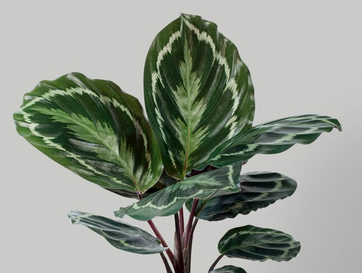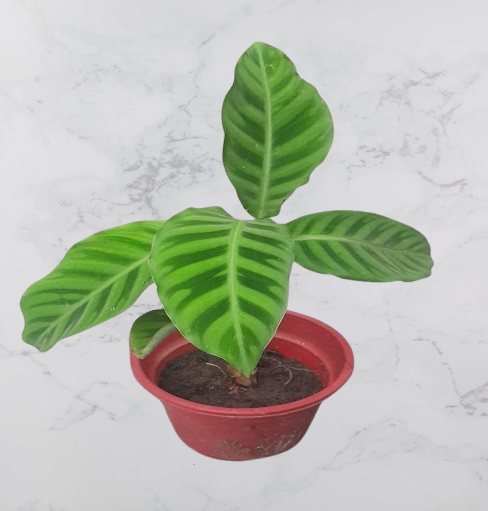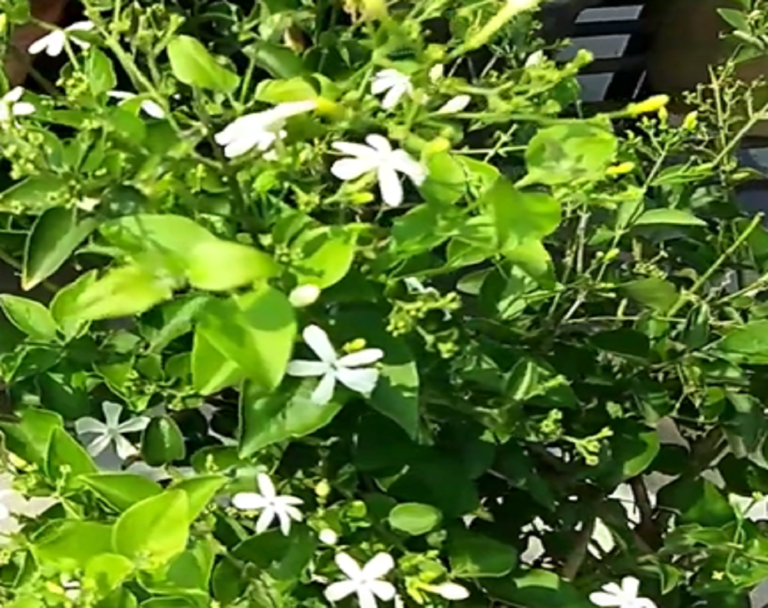Calathea is a genus of tropical plants known for their stunning foliage. Native to the tropical Americas, Calathea plants are admired for their large, decorative leaves, often featuring intricate patterns and vivid colors. These plants are commonly used as houseplants because of their ornamental value and relatively easy care. Calatheas belong to the family Marantaceae, which also includes plants like the Prayer Plant (Maranta leuconeura).
1. Botanical Characteristics
- Leaves: Calathea leaves are large, oval, or lance-shaped, with a variety of patterns such as stripes, dots, and marbling. The underside of the leaves is often purple or maroon, creating a striking contrast. The leaves are also known for their ability to move throughout the day, a phenomenon known as nyctinasty (the leaves fold up at night and open in the morning).
- Flowers: While the flowers of Calathea are less prominent than the leaves, some species produce small, inconspicuous blooms. The flowers are often white, purple, or yellow, but Calatheas are primarily grown for their foliage rather than their flowers.
- Growth Habit: Calatheas are herbaceous perennials, meaning they grow year-round without forming woody stems. They are typically low-growing plants with a rosette of leaves emerging from the base.
- Root System: Like many tropical plants, Calatheas have shallow root systems that benefit from consistent moisture without being waterlogged.
2. Popular Calathea Varieties
There are several popular varieties of Calathea, each known for its unique leaf patterns and colors. The following table highlights some of the most well-known varieties:
| Calathea Variety | Leaf Pattern and Color | Size | Special Features |
|---|---|---|---|
| Calathea orbifolia | Large, round leaves with silver and dark green stripes | 2-3 feet tall | Broad, eye-catching foliage; one of the largest Calatheas |
| Calathea makoyana | Also known as “Peacock Plant,” featuring green leaves with dark green spots and light green veins | 1-2 feet tall | Delicate, lacy pattern resembling a peacock’s tail |
| Calathea lancifolia | Also known as “Rattlesnake Plant,” with elongated leaves and wavy edges | 1-2 feet tall | Rattlesnake-like pattern with purple undersides |
| Calathea roseopicta | Dark green leaves with pink or purple lines forming a circular pattern | 1-2 feet tall | Striking pink to purple variegation on leaves |
| Calathea medallion | Large, oval leaves with a dark green center and light green edges | 1-2 feet tall | Medallion-like pattern with burgundy undersides |
| Calathea zebrina | Light green leaves with dark green stripes resembling zebra print | 2-3 feet tall | Velvety texture and bold zebra-like pattern |
3. Growing Conditions and Care
Calathea plants thrive in indoor environments with indirect light, high humidity, and consistent moisture. They can be more demanding than other houseplants, but with proper care, they can flourish.
| Care Aspect | Description |
|---|---|
| Light | Bright, indirect light is ideal. Direct sunlight can scorch the leaves, causing them to fade or curl. |
| Watering | Keep the soil consistently moist but not waterlogged. Water when the top inch of soil feels dry. Use distilled or rainwater if possible, as Calathea is sensitive to chemicals in tap water. |
| Humidity | High humidity (50-60%) is essential. Mist the leaves regularly, use a humidifier, or place the plant on a pebble tray with water to maintain humidity. |
| Temperature | Prefer temperatures between 65-80°F (18-27°C). Avoid cold drafts and sudden temperature changes, as they can cause the leaves to brown or curl. |
| Soil | A well-draining, peat-based potting mix is ideal. Mixes designed for African violets or houseplants are suitable. |
| Fertilizer | Feed monthly during the growing season (spring and summer) with a balanced, water-soluble fertilizer diluted to half strength. |
| Pruning | Remove any dead or damaged leaves to promote healthy growth. Pruning is minimal as Calatheas don’t grow tall. |
| Repotting | Repot every 1-2 years, or when the plant becomes root-bound. Choose a pot that is 1-2 inches larger than the current one. |
4. Common Problems
Although Calathea plants are beautiful and rewarding, they can be prone to certain issues if their care needs aren’t met.
| Problem | Cause | Solution |
|---|---|---|
| Browning Leaf Edges | Low humidity or exposure to chemicals in water | Increase humidity, use distilled or rainwater, and avoid tap water. |
| Yellowing Leaves | Overwatering or poor drainage | Ensure the soil drains well and allow the top layer of soil to dry out between waterings. |
| Leaf Curling | Underwatering or exposure to direct sunlight | Water more frequently and move the plant to a location with indirect light. |
| Pest Infestation (spider mites, etc.) | Dry conditions or poor air circulation | Increase humidity, regularly mist the plant, and wipe leaves to keep them clean. Use insecticidal soap if pests are present. |
| Leggy Growth | Insufficient light | Move the plant to a brighter location with indirect sunlight. |

5. Propagation
Calatheas can be propagated through division, which is best done during repotting in the spring.
- Steps for Propagation:
- Gently remove the plant from its pot and shake off excess soil.
- Identify natural divisions in the plant, where there are separate root clumps.
- Carefully separate the clumps with roots attached and plant them in individual pots with fresh potting mix.
- Water the new plants thoroughly and keep them in a humid, well-lit environment.
6. Cultural and Symbolic Significance
- Symbolism: Calathea is often associated with new beginnings, especially because of its ability to “pray” by folding its leaves at night. In some cultures, the plant symbolizes nature’s resilience and beauty.
- Cultural Uses: In certain regions, such as the Amazon, the large leaves of Calathea plants are used to wrap food or to create shelter due to their durability.
7. Conclusion
Calatheas are beloved for their striking, ornamental foliage, making them a popular choice for indoor plant enthusiasts. While they require a bit more care than other houseplants, their unique leaf patterns and the fascinating way they move in response to light make them rewarding plants to grow. With the right balance of moisture, humidity, and light, Calatheas can thrive in an indoor environment, adding a tropical, vibrant touch to any space.




